Credits
Feature by: Cullen Gallagher, Katherine Follett, Victoria Large, Matt Bailey, Leo Goldsmith, Thomas Scalzo, Eva Holland, David Carter, Evan Kindley, Timothy Sun, Jenny Jediny, Adam Balz, Stephen Snart, and Rumsey Taylor
Posted on: 22 June 2009
This feature christens a series of semi-annual canonizations of particular cinematic genres, movements, themes, filmmakers, and geographies. These are entitled Favorites, and are intended – much like our annual celebration of the horror genre, 31 Days of Horror – to be construed as broad yet selective overviews, and will be comprised of reviews published in a random order over the course of a month.
Summer, for many, affords the opportunity for every kind of outdoor venture possible, from kitesurfing to bocce, camping to badminton. For others, it is a time for action—that is, the type of action best experienced while seated in a plush seat with a quart of sugary soda to hand, the orange glow of an artificial explosion the only thing to brighten the dark frigidity of an excessively air-conditioned movie theater.
Depending on your point of view, the action movie is either (or both) the zenith or the nadir of cinema. To many, it exemplifies the spectacular excesses of the movies in general, presenting the most bloated, corruptive, and superficial of films, cynically designed for the delectation of that preeminent demographic: the teenage boy. But at the same time, it is a genre that pushes the margins of what is possible with the cinematic apparatus, even as it reaches back to the very basis of the movies: movement.
After all, what is cinema – any cinema – if not the mere record of kinetics on a two-dimensional surface? In this light, any movie is basically an action movie, and those few films that seek to flout the conventions of the movie as a parade of moving pictures (see La Jetée, among others) are exceptions that prove the rule. Etymologically and practically, action is the very basis of a medium that exists primarily to document movement. But what’s more, the action movie employs every conceivable aspect of the cinematic apparatus tocreate illusions of motion, as well: blocking, framing, editing, sound design, special effects, and the elastic, inimitable grace of the human body.
From Aristotle (or maybe even a little earlier) to praxeology and cognitive science, thinkers have explored theories of human action that seek to divine the processes by which people do things. Cinema, with a quasi-scientific lineage of its own, seems uniquely suited to contribute to these debates, or at least serve as an aesthetic analogue. After all, the cinema’s roots lie in the photo-empiricism of Muybridge’s zoopraxiscope, which settled his supposed wager with Governor Leland Stanford about whether a horse lifts all four of its hooves off the ground while galloping. In the actualities of the Lumière brothers and Edison, before narrative took hold of the movies, cinema was most useful and fascinating as a popular means of studying every kind of movement in time to be found in contemporary life. And along with dance and sexuality, violence was among the very first preoccupations of the movies.
As it relates to the film or literary genre, the word “action” seems mainly to derive from the military, in the sense of deploying combat maneuvers or deploying action against a country or force. (The source of the related sexual slang of “getting some action” is itself almost certainly military.) Quite significantly, the Oxford English Dictionary reports a cluster of new usages for the word “action” arising in the 1950s, including “action committee” (describing a communist force deployed to purge a society of non-communist elements), “action painting” (describing the method used by artists like Jackson Pollock, Willem de Kooning, and Franz Kline)1, and of course, from the realm of film criticism, “action-packed.”2
That the phrase “action-packed” continues to be a handy descriptor for the filmmaker demonstrates the unquenchable desire for film to offer motion – human, vehicular, cinematographic – at its most extreme, spectacular, and implausible. It is then something of a linguistic error to refer to an action film with anything but strings of capital letters, punctuated with exclamation marks. It is a genre full of movies that entertain scenarios of utmost exoticness and offer conflicts that pivot around fatalistic dilemmas, populated with characters – both good and bad, male and female – that exist at the antipodes of human physicality and ethics. They are FAST! BOMBASTIC! THRILLING! LOUD! and EXCLAMATORY! Action movies are also brazenly unrealistic entertainments, and in their evolution have become increasingly colorful and excited to the point of abstraction. They contain scenarios and emotions many of us will never experience, liberally exploiting the spectrum of human emotion.
As a discernible feature of narrative, action more or less begins with Edwin S. Porter’s 1903 film The Great Train Robbery, widely (and inaccurately) believed to be the first narrative film. The film culminates in the image of a gunman shooting his pistol directly at the viewer (a shot that is homaged in Goodfellas), which illustrates from the outset the extent to which narrative and pure cinematic showmanship have conspired to implicate the audience in the thrilling illusion of violence and mayhem.
In the American cinema, the western, the gangster film, the film noir, and the war film all use action and violence as a spectacular element in the service of their narratives, as do the various martial arts genres in the cinema of Asia. In countless instances, the grammar of action cinema in one country is translated and re-translated across cultures and cinematic idioms, but it is Hollywood cinema that quite predictably stakes its claim to hegemony for action as a film genre. Like war itself, action as a cinematic trope is an occasion for the assertion of nationalist fervor, and international action cinema bears its American influence like a battle-scar, as illustrated by a film like Akira Kurosawa’s The Seven Samurai, influenced by the westerns of John Ford and then adapted back into the American context with The Magnificent Seven.
Kurosawa’s action exemplar may be parsed into individual, climactic set pieces. These are integral to the plot, but nonetheless display the scope of the film in partition—they occur at night, in the morning, indoors, outdoors, on horseback, on foot, and feature a variety of weaponry and fighting styles. In one instance, there’s even an explosive fire. This “partitioning” or fluctuation in scenario constitutes much of the essence of the action movie, but in order for these set pieces to be maximally dire, the characters must receive the viewer’s sympathy—sympathy remains perhaps the action movie’s characterizing emotion. Without sympathy, action is baseless and superficial; with it, its hostility is made a rational response against oppression. In the case of The Seven Samurai, this sympathy engenders the classic direness of the film’s principle conflict: the imperialist threat against a modest village of defenseless farmers. The film occurs in a place I have never seen, and in another era entirely, but this conflict is clearly resolutely unfair—these farmers mustn’t only be protected, but those threatening the farmers’ fundamental benevolence must be permanently disabled.
But while fistfights, car chases, and medieval battles are traceable to the very origins of the cinema of every culture has that produced films, the release of Jaws and the creation of the summer blockbuster was a watershed in the history of the industry action movie. Spielberg’s movie fixed Hollywood’s grasp upon the summer with a film that itself boldly equates hot and healthy recreation with violent cinematic spectacle. America’s economic and consumerist boom of the 1980s ensured that Hollywood would continue to offer the world bigger, better, and louder iterations of the action movie. In the films of directors from Don Seigel to McG, Kathryn Bigelow to John Woo, a palpable obsession with male form and character takes sweaty, muscular shape, and stars like Stallone, Schwarzenegger, Seagal, Van Damme, and a thousand knock-offs cultivated physiques that would themselves burgeon with each film. In the pantheon of the action movie, Hollywood found an ideal medium with which to sell its mythologies of physical impenetrability and boundless prowess, the mastery of space, the preeminence of masculine strength, and a clear, conservative morality of good and evil. With these mythic figures and archetypal narratives, with their redemptive endings, explosions, car chases, robots, and monsters, the Hollywood action film crystallized a powerful and benevolent image of America that saw the country through to victory in the Cold War. And to this day, this myth largely obtains, while, like John Carpenter’s The Thing, it continues to absorb, imitate, and infect the cinematic myths offered by other cultures and genres.
And this, we believe, is precisely why the genre has remained so durable. Naturally, any generic category prescribes a loose set of criteria that can be reshaped (or, in the contemporary industrial parlance of the Hollywood remake, “rebooted”) as other aesthetic or critical priorities arise. But action is an even more mutable genre than most, crossing many generic lines (comedy, horror, drama) as well as national boundaries. Therefore, any project that seeks to narrow its parameters in hopes of discovering something essential or pure risks being incomprehensive.
Nonetheless, for the purposes of this feature, we depart from the notion that the genealogy of the action movie is traceable to distinctly American cinematic traditions. This notion may (and probably ought to) be characterized as hopelessly provincial, but given the hegemony of Hollywood in cinematic history generally and in this genre in particular, it seems an obvious primary assumption (and one that we will nonetheless be interrogating as we go). Therefore, in making our idiosyncratic, purely subjective selections, we’ve tended to avoid films and genres with specific roots in other cultures, literatures, and genres. So, for example, the martial arts films of Asia and the American western – vast categories more worthy of features unto themselves – are largely undocumented here. This is not because their films do not incorporate action, but rather because they derive from far older forms (like chanbara literature and kung-fu folklore, in the case of martial arts genres), and therefore have their own symbolism and sets of rules. Primarily, what we’re interested in is the action movie as something perpetually exported from and returning to Los Angeles, where its binary moralism and penchant for explosive spectacle have always seemed to have a home.
Every day for the next month (and periodically over the course of the summer), we’ll be exploring the many iterations and mutations of this sort of action movie as it manifests in America and throughout the world.
Introduction by Leo Goldsmith
- Of course, the advent of the photography and film, which afforded artists many new possibities for representation, greatly and irrevocably affected various aesthetic media, from painting to sculpture to performance, and beyond. It is an old bromide that photography set representational reeling, and that abstract expressionism was itself, in many ways, a response to the more direct and faithful means of representation that the camera provided. But the extent to which the cinema’s capturing of movement itself impacted art is somewhat less obvious. Action painters like Pollock and de Kooning sought to demonstrate inner and outer movement on their canvases, while various movements also sought dynamism and spectacle in various media: see Japan’s Gutai group, the performance art and “happenings” of figures like Joseph Beuys, Yves Klein, Allan Krapow, and Carolee Schneemann, the Fluxus artists, amongst many others. Many of these artists, working in various traditional and non-traditional media – dance, performance, painting, sculpture, conceptual art – even turned back to the cinema to document and proliferate their actions. Inspired by Fluxus, Viennese Actionists, like Günter Brus; Otmar Bauer, Kurt Kren, and Otto Mühl (whose Therapie-Komune is featured in Makavejev’s Sweet Movie), traded canvases for the human body (their own as well as their audience’s), performing an assaultive, coprophagic, and emetophilic art that owes much to P. T. Barnum and Bertolt Brecht, even as it presages such diverse cinematic figures as John Waters, Lars von Trier, Catherine Breillat, Gaspar Noé, and Matthew Barney. Films by artists like Andy Warhol (“Sleep” and “Kiss”), Dutch conceptual artist Bas Jan Ader (“I’m Too Sad to Tell You”), and British video artist-cum-filmmaker Steve McQueen employ single silent closeups in order to reinvest art and performance with the emotional primacy of physical action, in turn recalling a similar fascination that Edison displayed in his early actualities of sneezing and kissing.↩
- Many thanks to Evan Kindley for this bit of etymological research.↩
Title |
File Under |
Year |
|---|---|---|
| First Blood | Stallone | 1982 |
| The General | Silent | 1926 |
| The Running Man | Schwarzenegger | 1987 |
| Guns | Andy Sidaris | 1990 |
| Highlander | Sci-Fi Action | 1986 |
| Death Race 2000 | Carradine / Cars | 1975 |
| Scaramouche | swashbucklery | 1952 |
| Do or Die | Andy Sidaris | 1991 |
| Thief | Michael Mann | 1981 |
| Mission Impossible | De Palma / Cruise | 1996 |
| Bullet in the Head | John Woo / Asian Action | 1990 |
| Invasion U.S.A. | Norris | 1985 |
| Rambo: First Blood Part II | Stallone | 1985 |
| Bullitt | McQueen | 1968 |
| Hard Hunted | Andy Sidaris | 1992 |
| The Fugitive | Chases | 1993 |
| Kindergarten Cop | Schwarzenegger | 1990 |
| Under Siege | Seagal | 1992 |
| Dirty Harry | Eastwood | 1971 |
| Rambo III | Stallone | 1988 |
| Public Enemies | Michael Mann | 2009 |
| Day of the Warrior | Andy Sidaris | 1996 |
| The Good, the Bad, the Weird | Asian Action | 2008 |
| Straw Dogs | Sam Peckinpah | 1971 |
| Die Hard | Willis / McTiernan | 1988 |
| Rambo | Stallone | 2008 |
| Con Air | Jerry Bruckheimer | 1997 |
| Collateral Damage | Schwarzenegger | 2002 |
By Cullen Gallagher, Katherine Follett, Victoria Large, Matt Bailey, Leo Goldsmith, Thomas Scalzo, Eva Holland, David Carter, Evan Kindley, Timothy Sun, Jenny Jediny, Adam Balz, Stephen Snart, and Rumsey Taylor ©2009 NotComing.com
Reviews
-

First Blood
1982 -

The General
1926 -
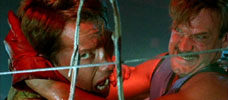
The Running Man
1987 -

Guns
1990 -

Highlander
1986 -
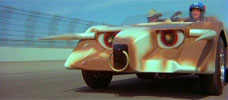
Death Race 2000
1975 -
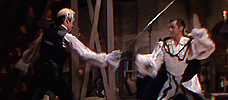
Scaramouche
1952 -
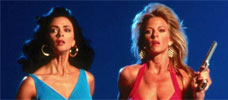
Do or Die
1991 -
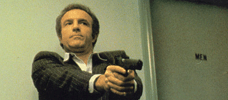
Thief
1981 -
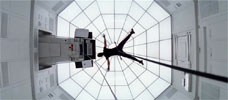
Mission: Impossible
1996 -

Invasion U.S.A.
1985 -

Rambo: First Blood Part II
1985 -

Bullitt
1968 -

Hard Hunted
1992 -
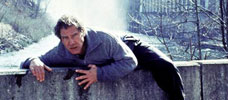
The Fugitive
1993 -
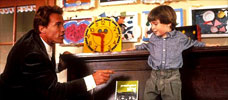
Kindergarten Cop
1990 -
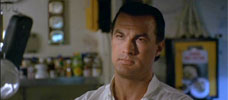
Under Siege
1992 -

Dirty Harry
1971 -
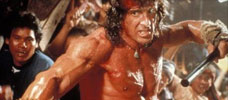
Rambo III
1988 -
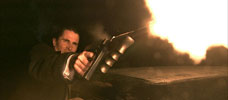
Public Enemies
2009 -
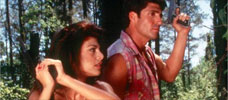
Day of the Warrior
1996 -

The Good, the Bad, the Weird
2008 -
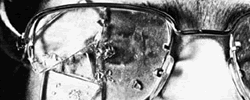
Straw Dogs
1971 -
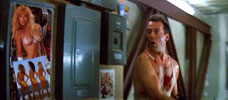
Die Hard
1988 -

Con Air
1997 -

Collateral Damage
2002 -
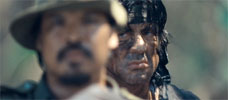
Rambo
2008
We don’t do comments anymore, but you may contact us here or find us on Twitter or Facebook.



